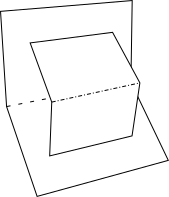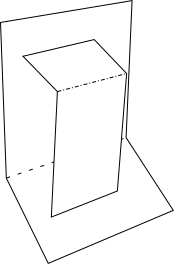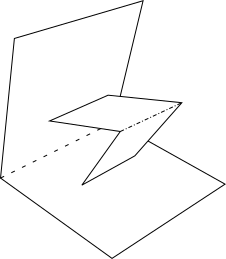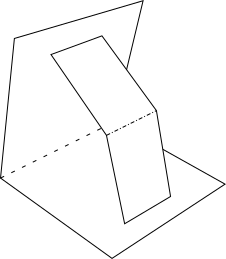Introduction: Instructables Pop-Up Card
A while ago (almost a year actually) I was wearing an Instructables shirt and my then 8-month old son couldn't stop touching the robot. So it was quite obvious something needed to be made which was suitable for him. A plush version of the robot is already on the site, so that sounded way to easy. I needed something where I could do some research, it needed to have simple basics, but I also like a challenge, so those basics should be able to be used to create something a little harder. I finally settles on pop-up book design. A year later and I finally finished the project.
Only two basic techniques are used for creating pop-ups, these are explained in steps "Pop-Up Basics". With these two techniques combined in different ways, complex movements and forms can be achieved. Some of the techniques I used in the final robot project can be found in steps "Pop-Up Advanced". And for even more techniques and info I'd advice you to go to The Pop-Up Channel on Youtube. An amazing place to find info on how to do pop-ups.
I designed the mechanics of my robot pop-up using CAD, that's the way I work and know how to do stuff with. Once the technical side was over, I went over to Inkscape to add the graphics. However, I do believe most pop-up designers have a bit of a different workflow. They start with the overall design using sketches. After that they experiment with real paper and techniques they know might work for the design. Once that seems to work they digitize all of it. My advice would be to do it the way fits you best once you've experimented with some of the basics using paper.
In the final step I've included a pdf of the robot pop-up card so you can make it yourself.
Step 1: Materials & Tools
Materials:
- White paper for the examples - regular printing paper should be fine
- White paper / cardstock for the final robot - I used 160 grams.
- Glue - Try to use a glue which doesn't warp the paper, test this out before you start.
Tools:
- Printer - I added the designs to every step. you can print these and fold along with the steps.
- Hobby knife - Obviously to cut out the design.
Optional:
- Dull blade - Pre-carve the fold for a more crisp fold.
- Children - I believe everyone will enjoy this card, but based on my son's reaction children will enjoy it the most.
Step 2: Pop-Up Basics
The basics of pop-up design are quite easy. When you open a page, certain shapes lift up from the book. When the page is closed, those shapes fold in again and you are left with a flat sheet.
The 'energy' which opens the shapes comes from the folds. When a structure is added to a fold, new folds are introduced. These folds can again act as the 'energy' to pop-up other structures. Two types of structures can be distinguished, a structure created by a fold which crosses the base fold (v-fold) and structures created by a parallel fold. By smart combinations of both types of fold, folds in any direction in the 3D space can be created at any location you desire.
All basic folds explained in the next steps can be made by printing out the pdf attached to that step.
Step 3: Pop-Up Basics: V-fold
As mentioned in the pop-up basics introduction, the v-fold crosses the base fold. This means that the angle between both folds (base and introduced) should be in equilibrium. If the angle is not in equilibrium, the page cannot be completely closed. In other words, α1+β1 = α2+β2 or α1-β1 = α2-β2, depending on the direction the fold folds to.
There are 2 main types of v-fold, symmetric and asymmetric. The symmetric fold is when α1=α2 and β1=β2. The asymmetric folds are all other v-folds. Within these main types, front leaning, balanced and back leaning can be distinguished. Front leaning is when the pointed edge of the fold leans towards base fold. Back leaning is when the pointed edge of the fold leans away from the base fold. Balanced is right in the middle, when the edge is standing at a 90 degree angle with respect to the base fold. In total this makes up 6 v-fold to be distinguished:
| Symmetric | Asymmetric | |
| Front leaning | 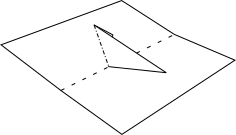 | 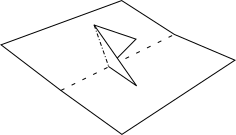 |
| Balanced | 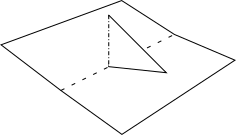 | 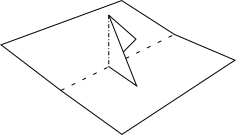 |
| Back leaning | 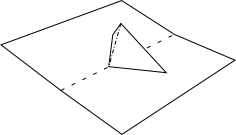 | 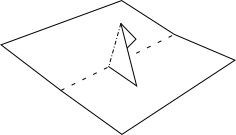 |
Attachments
Step 4: Pop-Up Basics: Parallel Fold
The parallel fold is parallel to the origin fold, so by definition the angle is in equilibrium. So to correctly balance the parallel fold, not the angle but the length should be in equilibrium. So a1+b1=a2+b2.
There are 2 main types of parallel fold, symmetric and asymmetric. The symmetric fold is when a1=a2 and b1=b2. A special symmetric fold is the square fold where all sides (a1, a2, b1, b2) have the same length. The asymmetric folds are all other parallel folds. An often used special one here is the rectangular fold, where a1=b2 and a2=b1.
| Square | Rectangular |
|
|
Within these main types, there are some additional types to be distinguished. Pointed edge is when the base is opened fully, the structure is standing up. Blunt edge is when the base fold is opened 90 degree, the introduced fold is opened more then 90 degree but less then 180 degree. And finally a special case of the blunt edge, where the introduced fold is folded toward the base fold, not away from it. An example for these three types can be found below for the symmetric fold.
| Pointed edge | Blunt edge | Inward fold |
|
|
|
Only open the base fold of the example 90 degree to see the results.
Attachments
Step 5: Pop-Up Advanced
In theory, you already have enough information to make the most elaborate pop-up designs you can think of. However, it is a lot easier if some additional 'advanced' techniques are already explained up front, so you don't have to figure it out yourself. So I explain a couple of them which I used in my final Robot pop-up card.
All advanced folds explained in the next steps can be made by printing out the pdf attached to that step.
Step 6: Pop-Up Advanced: V-fold & Parallel Fold
Outside mechanism:
When you open a pop-up, the v-folds and parallel folds not only create new 'inside' folds which can be used to create new mechanism, but also the 'outside' folds can be used. In these cases it is important to not only consider the main rules of the v-fold and parallel fold, equilibrium, but also that the added mechanism has a larger angle (v-fold) or a larger length (parallel fold). So α1<β1 & α2<β2 (v-fold) and a1<b1 & a2<b2 (parallel fold).
Used as the arms of the robot, but also the head.
| V-fold | Parallel fold |
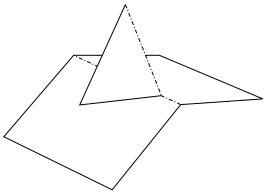 | 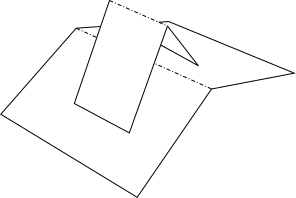 |
Standing structure:
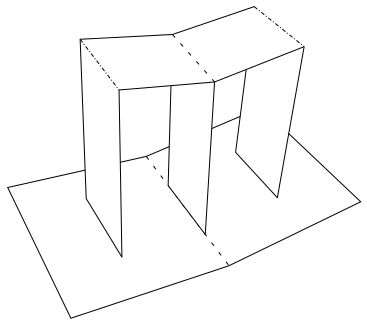
The standing structure is ideal as a base for things like buildings. It consists of the base and a horizontal plane/fold parallel to the base. Both are connected with 3 vertical legs, 1 connecting the folds and 1 on each side of the fold. When the base is opened, the structure will stand upright. However, depending on the paper you are using and the weight on top of the structure, it might be necessary to add additional bracing to keep the structure upright. Multiple options exist to brace the structure. Most common is the double 45 degree fold (see next step) or adding a parallel fold between the outside legs (similar to sphere in next step).
Used as the legs of the robot.
Step 7: Pop-Up Advanced: Combined V-fold & Parallel Fold

Angled parallel fold:
There actually is not much to say about this one. It is a v-fold with the point removed, so it looks like a parallel fold.
Used for the upper arms of the robot.
Double 45 degree fold:

To make something stand upright when the base fold is folded open, one can use this fold. The fold consist of a piece of paper added to the base fold and a 45 degree v-fold. The 45 degree v-fold is a symmetric v-fold, when folded open, spans 90 degree. Connect the piece of paper in the base fold using the 45 degree v-folds between both sided of the inserted paper and the base. Now, when you open the base fold, the piece of paper should stand upright.
Used in the legs (standing structure) of the robot to keep the robot upright.
Semi sphere:
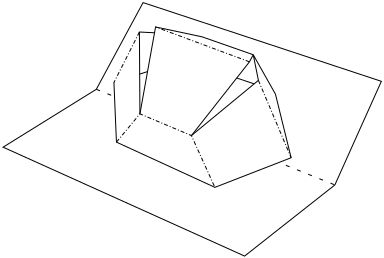
This one sounds harder than it is. But if we change the sphere into a polygon, it becomes much easier. Start with the standing structure from previous step. However, the two legs should now be replace with a semi circle polygon. The edges of the polygon are then connected using basic pointed edge parallel folds. Using a similar method it is also possible to expand the semi sphere to almost a full sphere.
Used as the body of the robot.
Step 8: Instructables Robot Thank You Card
Initially I wanted to design a complete pop-up book where every pop-up page would be accompanied by a double line of a poem. I even wrote the poem already. However, the first pop-up I designed was the Instructables robot (an even more complicated version then I show in this step) and it turned out to be quite hard. Not only the pop-up part, which I can manage, but especially the accompanying art itself. I like to draw, but am not nearly skilled enough to pull off an entire book within the time I like to spend on such a project. So the book was down scaled down to a single page. But at least now our favorite robot has a pop-up character.
As you will find in this step I've included two versions of the robot pop-up. The details on how to print and assemble can be found in the attached pdf as well. Please enjoy the pop-up card and leave an "I made it" in the comments.
For those interested in the poem:
The Instructables Robot had many human friends around,
But there was one kind of friend he still hadn't found.
Luckily for him, homemade robots were the latest trend,
So he decided to make himself a little robot friend.
He started gathering mechanical stuff like nuts and a bolt,
And in the middle of it all, should be a heart made of gold.
He started tinkering and a small robot came to be,
But an ashamed naked robot was all you could see.
So the Instructable Robot started searching again for supplies,
This time he gathered fabrics, cardboard, paint and other dyes.
Using tools and the materials found the robot was dressed,
And even his human friends were more then impressed.
The little Robot was no longer naked and wore his skin proud,
"We'll be friends forever", he told the Instructables Robot aloud.
Attachments

Runner Up in the
Paper Contest







